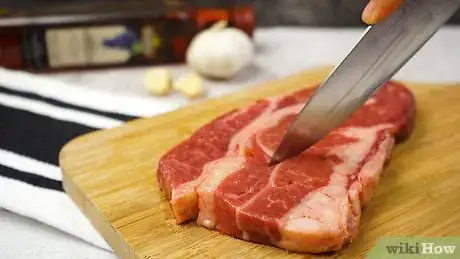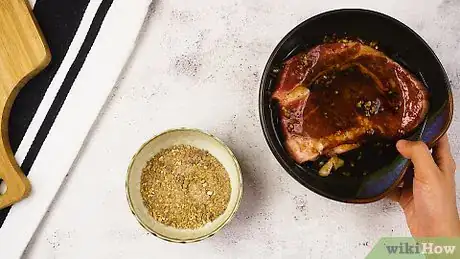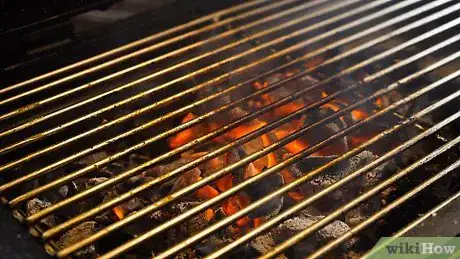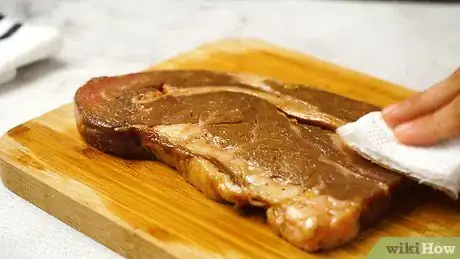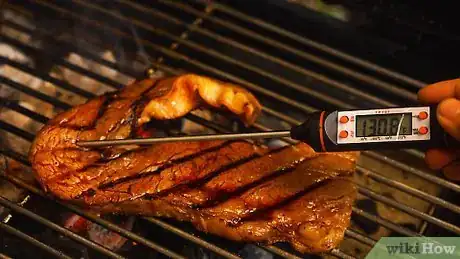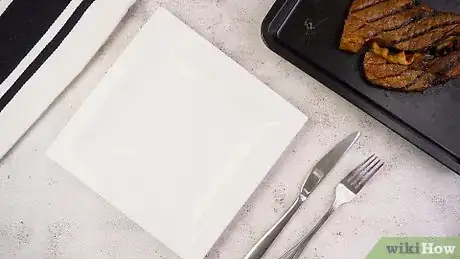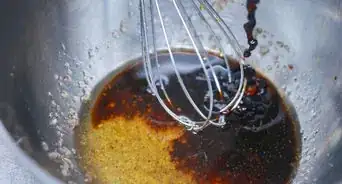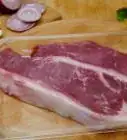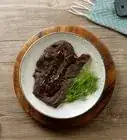This article was co-authored by wikiHow staff writer, Sophia Latorre. Sophia Latorre is a Content Manager on the wikiHow team. Before joining wikiHow, Sophia worked as a technical editor and was published in six International Energy Agency (IEA) Wind Annual Reports. Now, she writes, edits, and reviews articles for the wikiHow Content Team, working to make the content as helpful as possible for readers worldwide. Sophia holds a BA in English from Colorado State University.
There are 8 references cited in this article, which can be found at the bottom of the page.
The wikiHow Culinary Team also followed the article's instructions and verified that they work.
This article has been viewed 449,688 times.
Learn more...
Flank steak is a flavorful cut of meat taken from the flank (lower abdominal region) of the cow. In the hands of a budget-minded cook, flank steak can be a delicious yet affordable alternative to pricier cuts of beef like prime rib, T-bone, or ribeye. However, because flank steak can be somewhat tough, take care to preserve the meat's tenderness and flavor when cooking. Properly seasoned with a marinade or dry rub, grilled, and sliced against the grain, flank steak is a flavorful steak that is great for sharing with friends and family.
Ingredients
- High-quality flank steak (about 1 pound (0.45 kg) for every 3 people)
- Salt
- Pepper
Red Wine Vinegar Marinade
- 1⁄3 cup (79 mL) of olive oil
- 2 cloves of minced garlic
- 2 tablespoons (30 mL) of red wine vinegar
- 1⁄3 cup (79 mL) of soy sauce
- 1⁄4 cup (59 mL) of honey
- 1/2 tsp (1.165 g) of black pepper
Lemon and Worcestershire Marinade
- Lemon juice (from 1 lemon)
- 3 tablespoons (44 mL) of olive oil
- 1⁄4 cup (59 mL) of red wine vinegar
- 2 tablespoons (30 mL) of Worcestershire sauce
- 1⁄4 cup (59 mL) of honey
- Hot sauce or chili paste (optional)
Dry Rub
- 1 tsp (4 g) of ground cumin
- 1 tbsp (5.9 g) of salt
- 2 tsp (3.4 g) of ground coriander
- 1 tsp (2.3 g) of paprika
- 1 tsp (2.3 g) of black pepper
- 1 tsp (3.3 g) of garlic powder
- 1/2 tsp (0.85 g) of cayenne pepper
Steps
Scoring and Seasoning the Meat
-
1Score your steak to a depth of 1⁄4 inch (0.6 cm). Regardless of the seasonings you choose to use for your flank steak, begin by scoring it, especially if you have a thick piece of meat. Scoring allows both heat and seasonings to penetrate deeper into the meat. To score your flank steak, place the flank steak on a cutting board, then use the tip of a sharp knife to make several shallow cuts into the surface of both sides of the steak in a diamond pattern. Try to make each cut about 1⁄4 inch (0.6 cm) deep.
- If you can, cut against the grain of the meat. The general rule with flank steak is to always cut against the grain to reduce the meat's toughness.
-
2Choose a marinade or dry rub for your steak. If cooked correctly, flank steak can taste great without any seasoning at all. However, proper seasonings give this dish a burst of zesty flavor that can make it absolutely irresistible. When it comes to seasoning your flank steak, generally, your 2 options will be to use a marinade or a dry rub. Both options can result in great flank steak, but choose one or the other rather than both.
- Marinating your steak means letting soak in a mix of liquid ingredients so that it absorbs lots of flavor.
- A dry rub is exactly what it sounds like — a mix of dry ingredients that you rub onto the outside of the steak.
- Whether you're using a marinade or a dry rub, the basic process for preparing each is the same. Simply combine the ingredients and mix thoroughly until the ingredients are combined.
Advertisement -
3Soak your steak in the marinade for 4-24 hours. If you've chosen to add flavor to your steak with a marinade, begin by pouring the marinade into a large resealable plastic bag, then add the flank steak. Squeeze most of the air out of the bag, then seal it securely shut. Knead the bag to be sure the steak is completely coated in marinade. Leave the marinating steak in its bag in the refrigerator for at least 4 hours or overnight. The longer you allow your meat to marinate, the stronger it will taste.
- For a flavorful marinade, combine 1⁄3 cup (79 mL) of olive oil, 2 cloves of minced garlic, 2 tablespoons (30 mL) of red wine vinegar, 1⁄3 cup (79 mL) of soy sauce, 1⁄4 cup (59 mL) of honey, and 1/2 tsp (1.165 g) of black pepper.
- Alternatively, for a simple marinade, mix together the juice of 1 lemon, 3 tablespoons (44 mL) of olive oil, 1⁄4 cup (59 mL) of red wine vinegar, 2 tablespoons (30 mL) of Worcestershire sauce, 1⁄4 cup (59 mL) of honey, and a dash of hot sauce or chili paste.
- To make your own marinade, start with an oil base (like olive oil or vegetable oil) and add your preferred seasonings, including an acidic liquid (such as lemon or lime juice or vinegar) to cut the oil.
- If you don't have any resealable plastic bags handy, you can soak your meat in a bowl covered with plastic wrap, a Tupperware container, or any other plastic container with a seal.
-
4Apply your dry rub if you aren't using a marinade. On the other hand, if you're more interested in the tasty exterior crust that a dry rub provides, skip the marinade and apply your dry rub instead. Pour your dry rub into a large bowl and drop your flank steak in. Use your hands to toss your meat in the dry rub until it is completely covered. Be generous with your dry rub — you want every surface of your flank steak to receive a thorough coating.
- For a delicious rub, combine 1 tsp (4 g) of ground cumin, 1 tbsp (5.9 g) of salt, 2 tsp (3.4 g) of ground coriander, 1 tsp (2.3 g) of paprika, 1 tsp (2.3 g) of black pepper, 1 tsp (3.3 g) of garlic powder, and 1/2 tsp (0.85 g) of cayenne pepper.
- To make a dry rub, simply combine dry or powdered ingredients that you like. A good mix of sweet, salty, savory, and spicy flavors is always a good bet. Salt, pepper, brown sugar, paprika, garlic powder, and red pepper flakes would make a good combination, for instance.
- Let the meat sit until it reaches room temperature, or, if you're not grilling immediately, place it on a platter in the refrigerator.
Grilling to Perfection
-
1Fire up your grill. Whether you're using a gas or charcoal grill, you'll want it nice and hot by the time you plan to start cooking.
- For gas grills: Light one burner and set it to "high." Allow the grill to sit for several minutes (with the lid closed) so it can heat up. If possible, leave a second burner off so that there will be space to transfer the meat to for slow-cooking after the initial sear.
- For charcoal grills: Pour the charcoal into the bottom of the grill until the entire bottom surface is covered. If possible, push all of the charcoal to one side so that one half of the grill has no charcoal under it. This portion of the grill will be used for slow cooking after the initial sear. Light the charcoal and allow to burn freely until the flames die down and the charcoal turns mostly grey.
-
2Pat your meat down with a paper towel to remove excess moisture. When meat cooks on a grill, the characteristic black and brown "sear" that creates a crispy, delicious exterior can't begin to form until the moisture on the outer layer of the meat has evaporated. Since it takes a great deal of energy to evaporate water, grilling meat that's soaking wet is not only an inefficient use of the grill's heat, but also a bad idea for those looking to cook a crispy browned steak.[1]
- Discard any excess marinade.
- If you used a dry rub, you may not need to perform this step, as the powdered ingredients will likely have soaked up much of the moisture already, and patting with a paper towel can cause the rub to come unstuck from the meat.
-
3Oil the grates then add your steak to the grill. When your grill is nice and hot, carefully use a grill brush to paint the metal bars with extra-virgin olive oil or vegetable oil above the burner or charcoal. Then, transfer your flank steak to the grill directly onto the spot you just applied oil to. You should hear a noticeable sizzling sound as soon as the meat touches the grill surface.
- If you don't have a grill brush handy, you can try bunching up a paper towel and dipping it in your oil, then using this to paint the grill. Be careful when attempting this method, as it requires you to get your hand very close to the hot grill surface.
-
4Sear your meat on high heat for about 4 minutes on each side. Once you've placed your meat on the grill, let it cook undisturbed for about 3 or 4 minutes, then flip it over with a pair of tongs. If your grill was hot enough, your steak should have a good sear, meaning it's well-browned with crispy dark brown or blackened portions. If it is not well-seared, immediately flip it back over and allow it to continue cooking. Otherwise, cook the other side for 3-4 minutes before flipping again.
- Cooking the flank steak over high heat initially helps "sear" the meat, creating a crisp outer layer that tastes great and gives your meat a mouth-watering texture.
- Contrary to popular belief, searing the meat doesn't actually "seal in the moisture".[2] The steak's internal juices can flow out of the meat just as easily after it's seared as they can before. The primary reason for searing is simply for taste and texture — most people like a crispy, caramelized exterior on their meat.
-
5Cook the steak over low heat for 3 minutes per side. Transfer your meat to a cooler area of the grill with your tongs. On a gas grill, this means moving the meat over a burner that's set to "off", while, on a charcoal grill, this means moving the meat over the side of the grill that contains no charcoal.
- While high heat cooking is great for searing the outside, it's difficult to cook the meat all the way through over high heat without burning it. For this, low, steady heat is best, as it gives the inside of the meat a chance to catch up with the outside without burning the latter.
- Keep the grill lid closed as you cook the meat over low heat to keep the heat of the grill from escaping.
-
6Remove the meat when it reaches 130 to 160 °F (54 to 71 °C). Test the internal temperature with a meat thermometer. Stick the pointed end of the thermometer into the thickest part of the meat. Ensure that the tip is not touching the grill surface, then wait for a temperature reading.
- Generally, a reading of 130 °F (54 °C)) means your meat is cooked to a delicious medium-rare. Different readings can give different levels of done-ness, but you will want to take care not to remove any meat with a temperature of less than 120 °F (49 °C) or so, as undercooked meat can be unsafe to eat. Below are approximate temperatures for different levels of doneness:[3]
- 120 °F (49 °C): Rare
- 130 °F (54 °C): Medium rare
- 140 °F (60 °C): Medium
- 150 °F (66 °C): Medium well
- 160 °F (71 °C): Well done
- Generally, a reading of 130 °F (54 °C)) means your meat is cooked to a delicious medium-rare. Different readings can give different levels of done-ness, but you will want to take care not to remove any meat with a temperature of less than 120 °F (49 °C) or so, as undercooked meat can be unsafe to eat. Below are approximate temperatures for different levels of doneness:[3]
-
7Slice into the meat to check the doneness if you don't have a thermometer. As a general rule, the pinker the inside of your flank steak is, the less it has been cooked. Slice a thick section of the meat open to examine the inside. If the inside of your meat has a tougher texture than the outside, has a bright pink color, and/or has juices that don't run clear, your meat still needs to cook. If, on the other hand, the outside edges of the meat are brownish-grey while the inside retains a light pink color and the meat's juices run clear, you're ready to eat!
- For well-done flank steak, cook until the meat is just barely pink or greyish-brown all the way through. Note that because flank steak is naturally somewhat tough and cooking a piece of meat to well-done can cause it to become even tougher, this isn't usually done.
Serving Flank Steak
-
1Use clean plates and silverware for serving. After you remove the meat from the grill, don't allow it to touch any cutlery or plates that you used to handle it when it was raw. Either use entirely new serving utensils or wash the old ones thoroughly with soap and water before using them again.
- This prevents a condition called cross-contamination in which bacteria from the uncooked meat transfer to the cooked meat via unclean kitchenware. These bacteria can cause you to become seriously ill if ingested.
-
2Let the meat "rest" under aluminum foil for 10-15 minutes. When you remove the meat from the grill to a platter, cutting board, or another serving surface, don't immediately cut into it. Instead, allow the meat to sit for 10-15 minutes. Cutting into the meat immediately causes the meat's internal juices to spill out onto your plate or platter, leading to a less juicy, flavorful cut of meat. On the other hand, allowing the meat to "rest" for a short time gives the moisture a chance to be reabsorbed by the meat's muscle fibers, making the meat ultimately more tender and moist.
- Since flank steak is somewhat tough by its very nature, it's extra important to give it time to rest so that the meat is as tender as possible when you eventually bite into it.
- To keep your meat warm while it rests, take a piece of aluminum foil and fold it over the meat like a tent. The foil helps retain the meat's internal heat, ensuring your first bite is still pleasantly hot even after the meat has rested.
-
3Cut the meat against the grain. After it has rested, place the grilled flank steak on a cutting board. Examine the flank steak to determine the direction of its muscle fibers — there should be long, thin lines running in one direction on the surface of the steak. Use a sharp knife to cut the steak into thin diagonal slices against the grain of the muscle fibers. In other words, cut the meat at a perpendicular angle to the lines on the surface of the meat.
- Doing this helps make the meat as tender as possible. Much of the reason that flank steak is so naturally tough stems from the fact that its muscle fibers are fairly taught and strong. Cutting the meat against the grain severs the muscle fibers, releasing their hold on the meat and giving a more tender texture.
-
4Season your steak with salt and pepper and enjoy it. Congratulations! Your flavorful flank steak should be ready to eat. At this point, you may want to season the meat with salt and pepper or garnish with any extra ingredients of your choosing, though your meat should be mouthwatering as-is. Enjoy!
- Your flank steak should serve roughly 3 people per 1 pound (0.45 kg).
Warnings
- Cook your meat to an internal temperature of at least 130 °F (54 °C).⧼thumbs_response⧽
Things You'll Need
- Cutting boards
- Knives
- Bowl or resealable plastic bag
- Paper towels
- Oil
- Grill
- Tongs
- Meat thermometer
- Aluminum Foil
- Plates
- Silverware
References
- ↑ http://www.seriouseats.com/2013/06/the-food-lab-7-old-wives-tales-about-cooking-steak.html
- ↑ http://www.seriouseats.com/2013/06/the-food-lab-7-old-wives-tales-about-cooking-steak.html
- ↑ http://www.seriouseats.com/2013/06/the-food-lab-7-old-wives-tales-about-cooking-steak.html
- http://www.ochef.com/66.htm
- [1]
- [2]
- [3]
- [4]
- [5]
About This Article
To grill flank steak, start by applying any seasonings, dry rubs, or marinade that you want to flavor the steak before grilling. Then, heat the grill, and blot the meat with a clean paper towel to remove excess moisture. Place the steak on the grill, and let it cook on each side for 3-4 minutes to sear the meat. Lower the heat and cook the meat for 3 minutes on each side, or until the meat reaches your desired level of done-ness. For tips on making a dry rub or marinade and serving the steak, scroll down!
